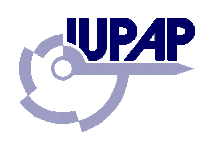International Union of Pure and Applied Physics
 | |
| Abbreviation | IUPAP |
|---|---|
| Formation | 1922 |
| Type | International |
| Purpose | To stimulate and facilitate international cooperation in physics and the worldwide development of science |
| Location | |
Region served | Worldwide |
Official language | English |
President | Cecilia Jarlskog |
| Website | IUPAP Official website |
The International Union of Pure and Applied Physics (IUPAP) is an international non-governmental organization whose mission is to assist in the worldwide development of physics, to foster international cooperation in physics, and to help in the application of physics toward solving problems of concern to humanity. It was established in 1922 and the first General Assembly was held in 1923 in Paris.
IUPAP carries out this Mission by: sponsoring international meetings; fostering communications and publications; encouraging research and education; fostering the free circulation of scientists; promoting international agreements on the use of symbols, units, nomenclature and standards; and cooperating with other organizations on disciplinary and interdisciplinary problems.[1]
IUPAP is a member of the International Council for Science (ICSU).
Committees and governance
The Union is governed by its General Assembly, which meets every three years. The Council is its top executive body, supervising the activities of the nineteen specialized International Commissions and the four Affiliated Commissions – it typically meets once or twice per year. The Union is composed of Members representing identified physics communities. At present 60 Members adhere to IUPAP. The Members are represented by Liaison Committees. Members of the Council and Commissions are elected by the General Assembly, based on nominations received from Liaison Committees and existing Council and Commission members.
The IUPAP specialised Commissions are:
C1. Commission on Finance
C2. Commission on Symbols, Units, Nomenclature, Atomic Masses & Fundamental Constants (SUNAMCO)
C3. Commission on Statistical Physics
C4. Commission on Cosmic Rays
C5. Commission on Low Temperature Physics
C6. Commission on Biological Physics
C8. Commission on Semiconductors
C9. Commission on Magnetism
C10. Commission on the Structure and Dynamics of Condensed Matter
C11. Commission on Particles and Fields
C12. Commission on Nuclear Physics
C13. Commission on Physics for Development
C14. Commission on Physics Education
C15. Commission on Atomic, Molecular, and Optical Physics
C16. Commission on Plasma Physics
C17. Commission on Quantum Electronics
C18. Commission on Mathematical Physics
C19. Commission on Astrophysics
C20. Commission on Computational Physics
The Affiliated Commissions are:
AC.1. International Commission for Optics
AC.2. International Commission on General Relativity and Gravitation
AC.3. International Commission for Acoustics
AC.4. International Commission on Medical Physics
In addition IUPAP has established a number of Working Groups to provide an overview of important areas of international collaboration in physics.
Sponsored conferences
Each year, IUPAP endorses approximately 30 international conferences and awards grants to the majority of them. Applications for sponsorship can be made via the IUPAP website.
Sponsored conferences fall into four categories:
General Conferences - Type A
These provide a broad overview of an entire field (typically the field of interest to a Commission), and normally occur at two- or three-year intervals, as advances in the field warrant. Attendance in the range of 750-1000 would be anticipated.
Topical Conferences - Type B
These concentrate on broad sub-fields (e.g. nuclear spectroscopy, nuclear reaction mechanisms, heavy ion physics, are possible sub-fields in the field of Nuclear Physics). They would normally be scheduled in the years between the corresponding Type A General conferences. Attendance in the range of 300-600 would be anticipated.
Special Conferences - Type C
These concentrate on much more specialised topics than in the case of Type B Conferences (e.g. angular correlations, lifetime measurements, neutron resonance studies in the field of Nuclear Physics). Attendance in the range of 50-200 would be anticipated.
Workshops in Developing Countries - Type D
These concentrate on meeting the needs of a developing region. Unlike the Type A, B and C conferences, they do not need to be truly international, but should involve neighbouring countries, and they should address the needs of the region. One Type D conference will be approved each year. All applications for Type-D Conferences must be submitted to the Commission on Physics for Development (C13).
Sponsored awards
IUPAP commissions sponsor various awards for scientists. These include:
- The IUPAP Young Scientist Prize, approved and adopted at the 2005 General Assembly for all commissions.
- The SUNAMCO Medal, given by the Commission on Symbols, Units, Nomenclature, Atomic Masses and Fundamental Constants (C2)
- The Boltzmann Medal, awarded by the Commission on Statistical Physics (C3)
- The Fritz London Award, given by the Commission on Low Temperature Physics (C5)
- The Young Author Best Paper Award, established by the Commission on Semiconductors (C8) and sponsored by the semiconductor industries of USA, Japan and Europe
- ICM Award in Magnetism, established by the Commission on Magnetism (C9)
- The ICPE Medal, sponsored by the Commission on Physics Education (C14)
- Penning Award Excellence in Low-Temperature Plasma Physics, established by the Commission on Plasma Physics (C16)
- ICO Prize, awarded by the Affiliated Commission for Optics (AC1)
- ICO Galileo Galilei Award, awarded by the Affiliated Commission for Optics (AC1)